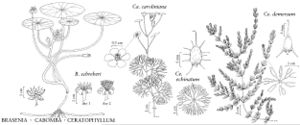Cabombaceae
Herbs, perennial, aquatic, rhizomatous; roots adventitious; air chambers conspicuous in vegetative portions of plant. Rhizomes branched, repent, slender. Leaves arising from erect stems with shortened internodes, submersed and floating; stipules absent. Leaf-blade: laticifers commonly present. Submersed leaves (Cabomba only) opposite [whorled], short-petioled; leaf-blade palmately dissected. Floating leaves alternate; petiole short to long; leaf-blade peltate, linear to broadly elliptic, sometimes with basal sinus (some Cabomba), margins entire. Inflorescences axillary, solitary flowers. Flowers bisexual, protogynous, diurnal, borne at or above water surface (occasionally submersed); peduncle long; involucre absent; perianth persistent in fruit, hypogynous; sepals usually 3, distinct or nearly so; petals usually 3, alternate with sepals; stamens 3–36, rarely more; filaments slender; anthers dehiscing by longitudinal slits, without connective appendage; pistils [1–] 2–18, 1-carpellate, inversely club-shaped or swollen on one side; ovary 1-locular; placentation laminar; ovules [1–] 2–3 [–5]; style short; stigma capitate or linear-decurrent. Fruits achenelike or folliclelike, leathery, indehiscent. Seeds 1–3, aril absent; endosperm sparse; perisperm abundant; embryo minute; cotyledons 2, fleshy.
Distribution
Temperate and tropical
Discussion
Genera 2, species 6 (2 genera, 2 species in the flora).
Cabombaceae are pollinated by insects (Cabomba) or by wind (Brasenia).
Formerly Cabombaceae often have been included in Nymphaeaceae in the broad sense.
Selected References
Illustrations
Key
| 1 | Plants with opposite, dissected, submersed leaves and (when flowering) with inconspicuous, alternate, linear-elliptic floating leaves 0.6–3 cm; stamens 3–6; submersed parts barely coated with mucilage. | Cabomba |
| 1 | Plants with only alternate, entire, broadly elliptic floating leaves 3.5–13.5 cm; stamens 18–36(–51); submersed parts heavily coated with mucilage. | Brasenia |
